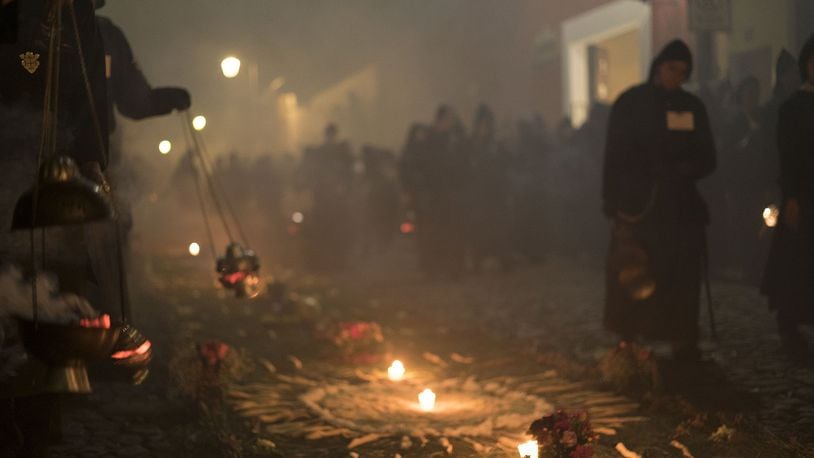RELATED: STAFFORD: Local artist may have hit breakthrough after years of work
Because he didn’t, Winebrenner will have a chance to visit his mother, Marie Wiseman, this weekend on his way from Washington University in St. Louis to Calvin College in Grand Rapids, Mich., for screenings of his film “Guatemala: On the Edge of Discovery.”
Two things happened that led him to delve into the region he had sworn off. First, he met Jose Antonio Gonzalez and Emilio Faillace, his Guatemalan guides.
“Their enthusiasm for their country was contagious,” Winebrenner said.
And when Winebrenner overheard Gonzalez say in a phone conversation they should be called “cockroaches in rags” for the shoestring budget they were working on, Winebrenner capitalized the C and R and ran with the name.
DETAILS: Springfield resident finds comfort playing piano
While befriending his guides, “I got a call from a guy who books filmmakers into small venues,” Winebrenner said, the kind of series the Audubon Society held at North High during his childhood.
Added to YiDonoy’s decision to cover the cost of materials, that made the project feasible.
From the start, the Cockroaches in Rags production had two watchwords for the project: authenticity and accuracy.
Guatemala’s recent history of devastation by earthquake and civil war is one reason more than a million Guatemalan expatriates live in the Los Angeles area. Although this was something that couldn’t be ignored, his guides persuaded Winebrenner that those things also have served to blind even Guatemalans to their nation’s natural beauty and rich history.
The 78-minute documentary that tries to move Guatemala closer to the edge of rediscovery opens with a 25-minute treatment of the country’s diverse landscape, which rises from sea level to 13,000 feet. Along the way, there’s a stop at a place that, in a mere 40 acres, is home to 185 species of animals.
Like large swaths of Guatemala, “It’s a naturalist’s paradise,” Winebrenner said.
READ MORE: Stafford: J.D. Vance talk a chance to reflect on ‘Springtucky’
The film then explores what its maker calls “the fluorescence of the Mayan culture,” a phrase he would not have used when he first arrived, looked at the Mayan ruins and saw in them little but “piles of rocks.” Winebrenner, who is 59, confesses he has become “a bit of a geek on Mayan history.”
Even non-geeks are likely to enjoy the handful of minutes the film spends giving a brief account of the breaking of the Mayan code, which helped moderns to understand and interpret hieroglyphs on ruins and expand awareness of the Maya.
As interesting is the film’s exploration of syncretism, the ways indigenous and Catholic religions have grown together like like trees wrapped by vines in the centuries since Columbus brought European religion to the New World.
That segment includes a portrait of the followers of Masimos, a shadowy figure whose name the church has changed to San Simon. Winebrenner said that poorer Guatemalans who find that “earthly institutions aren’t delivering the goods” bring offerings of rum and cigarettes to Masimos to enlist his help in the struggles of everyday life.
The shamans of Guatemala also appear in the segment. Considered masters of the Mayan calendar, they are hired by relatives of the departed to carefully arrange candles, incense and tobacco to create a portal into the world of the dead, then light the candles and consult the patterns of wax flows for messages from the beyond.
MORE COVERAGE: Springfield church to close after 129 years
In a film lush with visual interest, one of the highlights is the pageantry of Guatemala’s festive pre-Easter parades, in which musical groups march through incensed streets behind people carrying floats or pictures of Stations of the Cross.
Even to a jaded traveler, Winebrenner the “theatrical, elaborate, highly orchestrated” procession is “spine-tingling.”
In making this, his longest film, Winebrenner endured fear first over having too little material, then too much, and gradually moved on with a growing sense of hope as the project took shape.
“It’s like a master’s thesis,” he said. “You get to take this deep dive into something that’s of interest,” and see what happens.
His own hopes about the film were confirmed when the counsel general at the Guatemalan Consulate in Los Angeles told him it was the best film he’d seen on the country.
Because it features interviews with two highly prominent archaeologists, David Sedat and Richard Hansen, Winebrenner is hopeful that the film will be screened at the Los Angeles County Museum of Art, which might put it on the radar of someone who might pick it up for wider distribution.
Meanwhile, he will be heading back to Cuba, whose architecture he knows so well from “The Splendor of Cuba,” which made the Washington Post’s list of best photo books of 2011, to shoot and narrate another film.
After that, it’s hard to tell.
As he says on his website, winebrennertravels.com, “When I’m not traveling, I’m thinking about it.”
And Winebrenner is always thinking.
About the Author
